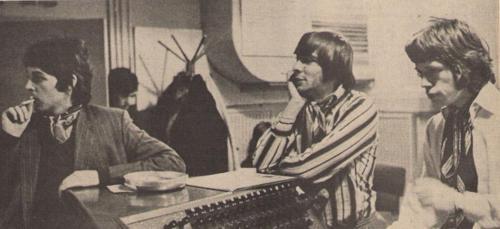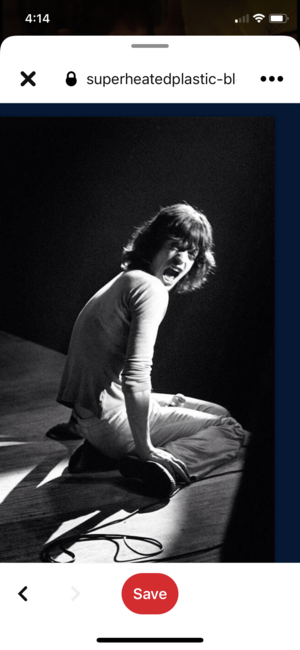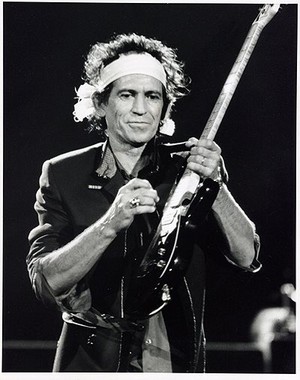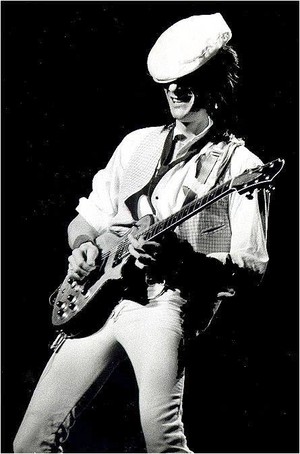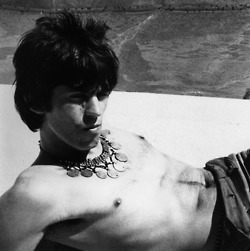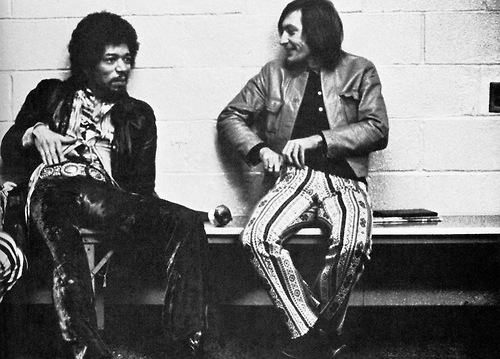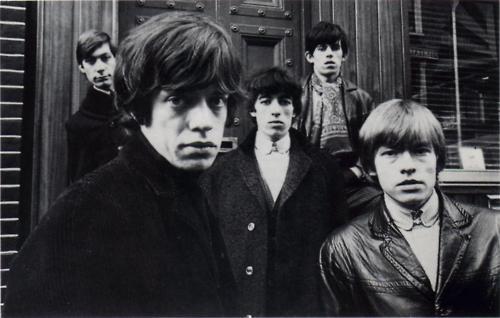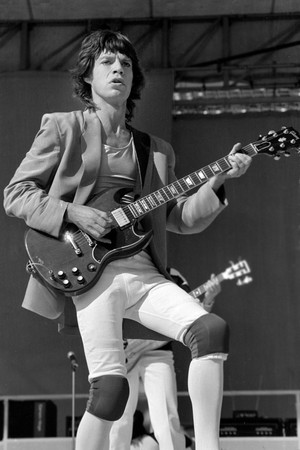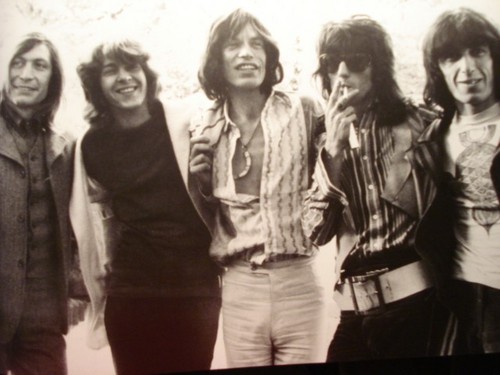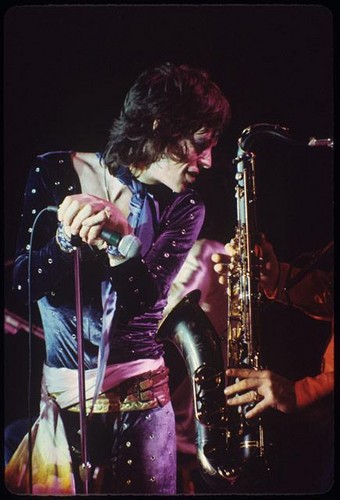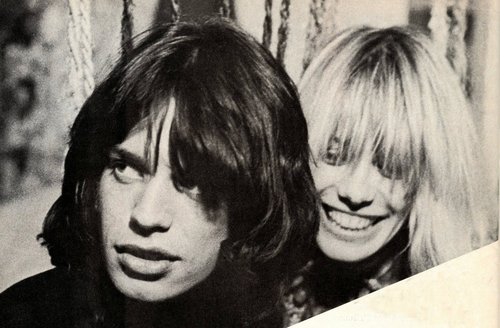With Keith Richards’ nod, I was hired to put together a one-shot magazine, Inside the Voodoo Lounge, to be sold at venues and newsstands during the Rolling Stones’ 1994-1995 World Tour. The first part of my assignment was to fly to Toronto, where the Stones had taken over a boys’ prep school for their rehearsals, and interview each member of the band. I was thrilled to be talking to Charlie Watts, a प्रिय ढंढोरची, ढोलकिया ever since “Satisfaction” and “Get Off Of My Cloud” hit the airwaves.
My first glimpse of Charlie was in a वैन, वान shuttling crew members and musicians from the Four Seasons Hotel to the rehearsal. On the way over, he amused us with an anecdote about a tall Stetson hat his wife had just dissuaded him from buying. When we pulled up, Watts got out first, turned, and offered a helping hand to each of the passengers. As I disembarked, he politely introduced himself. Our interview began shortly afterward in the school’s large cafeteria. Forewarned that Charlie’s modesty makes him a tough interview, I thought it best to begin द्वारा asking about musical heroes.
(As with all of my blogs, this new and complete transcription was made from the original tapes. The interview took place on July 14, 1994.)
****
If आप could somehow visit any musical period या see any artists, where would आप go first?
Good Lord! God, there’s loads of them, isn’t there? I’d like to have gone to the Savoy Ballroom – Chick Webb, I think. I’d loved to have seen Ellington at Cotton Club and have dressed up for the occasion. I’d प्यार to have seen Charlie Parker at the Royal Roost या something like that. Louis Armstrong, probably at the Roseland Ballroom in Chicago.
Which era?
1930, with a big band behind him. I like Armstrong with a big band. I mean, I like the Hot Seven and all those, but I like him with a big band.
Were आप a प्रशंसक of Jo Jones?
Yes. I just bought a record of Jo Jones, “Shoe Shine Boy,” Jo Jones Special. Yes, I saw him play quite a few times – Papa Jo Jones, आप mean, the Count Basie Jo Jones.
Have आप looked up any of the historic jazz drummers, such as Roy Haynes?
I know Roy Haynes. I know Micky Roker. I mean, I’ve met them. I think Roy Haynes is a wonderful player. One of my प्रिय drummers is Davie Tough – nobody knows anything about him, really. He’s one of the Austin High School Gang, out of Chicago in the ’30s. Played with all the big bands, and he played with the famous first Herd, Woody Herman’s. He’s the ढंढोरची, ढोलकिया on “Caldonia” and “Northwest Passage” and all that. He’s a legend. Every band leader wanted him in the ’30s. Skinny guy. And another guy I’d प्यार to have seen play – this is drummers we’re talking about – was Big Sid Catlett, who was around for the same era. They were the two drummers that were famous – Big Sid and Davie Tough. Davie Tough was a skinny white man, really skinny, and was a really loud player, apparently, from what I’ve gathered asking people like Mel Lewis about him. And Big Sid was a huge black man, but very light. So they were totally contrary in their stature to the way they played, which is very strange. Ahmet Ertegun is the only one I actually asked a lot about this. Ahmet is very interesting, and his brother was.
What can a young ढंढोरची, ढोलकिया today gain from listening to these players you’ve just mentioned?
That there’s nothing really new. Georgie Wettling is one of the great Chicago drummers, a great, great, great Chicago drummer. In fact, Georgie Wettling is better documented than lots of people. He used to play with Eddie Condon. He’s a fantastic drummer, and he is so subtle – it’s like Freddy Below is a great subtle drummer, really, although he’s feet-first and it’s noisy. But it’s actually very subtle, the pick-ups he does. I mean, the thing with blues bands, like records, is आप never quite know who’s on ’em, really. It’s all up to whether [Chess engineer] Ron Malo wrote the name down directly on the day. If आप go further back आप don’t know who’s on ’em. So if Freddy Below is the player on “Smokestack Lightnin’” द्वारा Howlin’ Wolf, that’s really clever drumming. That isn’t just straight-ahead. He plays lovely things with his feet.
What did आप think of Odie Payne, the other house ढंढोरची, ढोलकिया at Chess Records?
I don’t know who that is. You’d have to play a record for me to know him. Below, I know of and have seen. But there are a lot of guys unheard of, really, who play wonderfully. I mean, I personally like band drummers. All the drummers that I’ve mentioned या I admire – all the records I have of Roy Haynes, for example – are all rhythm records. आप know, the Coltrane thing, A Different Drummer, and he did some wonderful records with Roland Kirk – Out of the Afternoon and all those. It’s not the drum solos I like, it’s the rhythm section drumming. Max Roach is another one like that, who’s a phenomenal player.
Who was your प्रिय ढंढोरची, ढोलकिया with Miles Davis?
Miles? Don’t know a favorite. He had a way of putting bands together so आप never heard of them. My प्रिय drummer, I suppose, on record would be Philly Jo Jones, and to see play live, Tony Williams – द्वारा a long way. And Tony’s और important, really, because he turned drumming around. Nobody played like Tony Williams did when he was 18. When I first saw him he was 18. Nobody played like that. आप didn’t drop time. Philly Jo would ride, आप know, and it would be straight through. Tony would drop. Have आप got the [Miles Davis] album Four and More? That’s a classic example of Tony Williams’ way of playing the drums. The way I play and the way most guys played until he arrived would be to play straight through – आप know, one, two, one, two, one, two. Foot, foot. Left foot, right foot, left foot, आप know. But Tony would go tt-tt, tt-tt, tt-tt, tt-tt with his left foot, and nobody ever did that sort of thing. They didn’t play time like that. He would drop time, he would halve it. And him and Run Carter invented this way of playing. Important. आप know a guy called Scott LaFaro, the बास player? Him and Paul Motian used to do it with Bill Evans. They’d play a time inside the time, and nothing would be keeping time, except one note on the बास would be the anchor.
During the ARMS Concert, it was telling to see Kenney Jones’ gigantic drum setup alongside yours, which is a case-study in simplicity.
That’s how I’ve always played. I have a hard enough job playing them; I don’t really want to play more.
Have आप always admired the elegance in simplicity?
Yeah. I mean, Micky Roker is a beautiful-looking drummer. He just is wonderful. Philly Joe is. Elvin’s like that. When Elvin Jones gets going, it rolls. It’s like thunder and everything, but to watch him, it just rolls ’round. The arms go. When I was young, my प्रिय ढंढोरची, ढोलकिया was a guy called Joe Morello. And Joe Morello was all taste and elegance in his playing – superb ears and technique. आप know, it’s very hard to play with just a piano. Piano, bass, and drums is one of the hardest things for a ढंढोरची, ढोलकिया to play, to support, because of all the textures आप have to use.
Do आप play styles your प्रशंसकों might be unaware of?
I’m not aware of it.
Do आप play every दिन when you’re not working?
No. I used to practice every day. I don’t anymore.
Do आप collect historic drums?
Yeah. But, see, I collect anything, not only drums. I do. I collect anything. And there’s lovely old drums. I collect snare – most drummers collect snare drums. I have quite a lot of them, and they go back to 1926.
Have आप used an old set on record?
No. I’ve got an old 1926 drum kit, आप know, that contracts, with things on the top. I’ve got one of those. I don’t really like those. I like the ’40s type.
What’s your all-time प्रिय setup?
The make is Gretsh. The one I’ve got behind the curtain downstairs is also very good. It’s a 1960 black Gretsch, a Tony Williams one, 18″ बास drum. I bought it about a साल ago, and I’ve been playing it here. I’ve been messing about with it myself, with the band. But the one I’ve got now is about my favorite. I’ve used it on my jazz record things that I do, the Stones stuff. A guy from S.I.R. [Studio] brought it along to Ronnie Wood’s when we were making – Ronnie will tell आप what album it was, I’ve forgotten – in Los Angeles. And I fell in प्यार with it. It’s a ’58, I think, Gretsch. So I have a few. For snares drums, I’ve got mixtures of Leedys and all that, but most of my kits are Gretsch. I have a green-glitter and gold-plated Gretsch kit from about 1958. I had that done because I saw Mel Lewis with Stan Kenton when I was a kid. Some guy offered me a green glitter – they’re fantastic – and so I had it gold-plated. Lovely thing, but don’t think I’ll ever use it, but it’s a lovely looking thing.
Keith mentioned that आप took a और active role in the making of Voodoo Lounge than on past projects.
Where did he say that?
In the गुलाबी section of the San Francisco Chronicle.
Oh. I don’t know.
He mentioned you’d recorded in a सीढ़ियों, सीढ़ी and were और involved with the mix.
Oh, yeah. Well, I don’t know. I wasn’t that involved with the mixing. I was probably just talking to Don Was या Don Smith.
What’s the monster drum sound on “Thru and Thru”?
That is the stairwell. I think it’s on four या five songs on the album. “You Got Me Rocking.” [Glances at the Voodoo Lounge CD booklet.] Oh, and I play a trash can in the सीढ़ियों, सीढ़ी on “Moon Is Up.” It’s a four-flight stairwell, and I started off at the top, which is “Moon Is Up,” and I landed up at the bottom playing “You Got Me Rocking” and “Thru and Thru.”
Literally?
Yeah. The studio’s at the top. It’s like going down, then? So it’s open all the way down. So we started off out द्वारा the door there, and then Don Smith said, “Would आप go to the bottom and try it?” It was a bit small down there, but it was all right. The problem is आप can’t hear anything down there except drums – such tremendous sound.
What are your observations on playing with Darryl Jones?
Very easy. And I don’t mean that comfortably easy; I mean, he’s very comfortable to play with. He’s a rhythm section player. Well, the role he plays with us, he’s doing that. I don’t know how he would play if he were in a different type of band. Someone as talented as Darryl could play anything. That’s what being a professional musician is about – one side of it is being able to do these things. With us, he’s very quick to pick things up, very much a rhythm section within a rhythm section. He doesn’t play on चोटी, शीर्ष of the rhythm; he’s underneath it, which is what we need, really. Foundation. आप can’t have someone playing over the top, because there’s no room then. There is nothing at the bottom and no room for anybody else. So I actually find him very comfortable to play with. He’s a very nice man as well, which is half of it. When we did the auditions, I’d never auditioned people before, for anything – I haven’t. We auditioned them, and there were lots of guys, आप know. We landed with three या four, and really it was a सवाल . . . आप know, there is a certain caliber of musician that could do the job. It’s then a सवाल of, do आप think – and then आप hope – that आप can get on with this guy. For the अगला two years, you’ve got to be together. And he seems very nice. Well, he is very nice.
Bill Wyman has कहा that the difference between the Rolling Stones and other rock bands is that the Stones follow the rhythm guitarist, who is Keith Richards.
Yeah. Yeah, I always do. I don’t need to hear the rest of the band if Keith is there. I mean, now it’s different because आप have PAs that are so good, but at one time that’s all I could ever hear. I used to have the amplifier right अगला to me. I still do, but it was essential at one time, when आप didn’t have any monitors या they were really not very good.
Keith’s sometimes been accused of turning the beat around.
That’s because we all . . . I mean, the thing with me and Keith is that we just have a go at things, and sometimes they work. I mean, analyzing it all after is another thing, and that’s for somebody else to do. We just enjoy playing, and I just follow what he’s doing.
What do आप have to do to get ready to tour?
There’s no way आप can practice doing this. आप have to get your hands used to going, but आप never really reach that until you’ve done two या three shows. You’re just trying to condition yourself so that your arms don’t ache. It’s not really the aching, it’s actually the cramp that आप get. [Rubs edge of hand]
In your hand?
Anywhere, anywhere. Your body, आप know. You’re not doing anything, and all of a sudden you’re doing this for two hours, constantly, very hard. And it causes certain reactions. So I, personally, spend at least six weeks practicing. Most of the time it’s physically getting conditioned so that आप get through a two-hour show. आप know, sometimes we rehearse eight, ten hours a दिन – for that reason. I do – I don’t know how the others look at it, got no idea. The problems aren’t the same with a गिटार player. Drumming is a very physical thing. Well, I stretch, but see, I do that anyway. I really don’t do anything special, except practice when we are rehearsing. I never practice with drums at घर when I’m not doing anything.
If आप had a child . . .
I do!
Who wanted to become a professional rock drummer, would आप suggest . . .
No. I would say be a drummer, not a rock drummer. What the fuck’s a rock drummer? I mean, I don’t know what a rock ढंढोरची, ढोलकिया is.
Bonham, for one.
Well, that’s John Bonham playing with Led Zeppelin. Is that rock and roll?
It’s part of it, sure.
What would I say to him? I wouldn’t say anything.
Would आप suggest a course of study, people he या she should hear?
Yeah. I would say learn to read संगीत and listen to other people other than John Bonham. Now you’ve got totally the wrong impression about what I just कहा – I can see it in your face. [Leans आगे and speaks carefully.] John Bonham is the best at being John Bonham and doing what he does. या did – unfortunately, he’s dead. He was the best. There wasn’t anyone better than John like that, and thank goodness we’ve got some records so that आप can hear it. But there are a lot of other people.
Ginger Baker was a much better ढंढोरची, ढोलकिया than John Bonham, if आप really want to know about drumming. Ginger Baker is the best ढंढोरची, ढोलकिया to emigrate out of England. Really, Ginger is. And the guy who Ginger idolized – whatever the word was – we all did – was a guy called Phil Seaman. And Ginger learned everything off Phil. But Ginger can read, आप know. Ginger’s not a foal. He can read music, he has wonderful chops, he has rudiments down. Having कहा all that, I don’t. So I would say to anyone – not only my offspring, but anyone – that’s what आप should do, really. Otherwise, you’re locked into doing what I do. Which is fine. It worked for me.
The most important thing of all of it is to be you. There’s a load of people who play brilliant drums, but there’s only one Billy Higgins. There is only one Elvin Jones. There’s only one . . . And the reason there’s only one of them is their personality. Elvin is a huge black dynamo, आप know. Naturally when आप listen to him go, that’s what he sounds like. And it doesn’t have to be fast. It is this machine going. It’s not a machine that’s clicking regular; it’s what Miles used to call “between the beats.” It’s African. It’s what he is, man. Ginger is the same. Ginger is this skinny, huge white man who plays monstrous. But Ginger played like that when he was 20. I used to see him play.
Before Cream.
Yeah! God, he took over for me with a band in England, Alexis [Korner’s Blues Incorporated], but I used to know him before that – 1960. I first heard Ginger playin’ in 59, I think. And he was bloody good then. Don’t mean good – I mean bloody good. Him and Jack Bruce used to play in one of the best – well, the most exciting, if it wasn’t the best – jazz groups in London. And आप don’t get in those bands द्वारा being half good. They were very good. ’Cause there’s a lot of guys who are very good.
Did आप hear Ginger on the Masters of Reality record?
No. I kind of लॉस्ट track of Ginger’s recording career because he disappeared to Italy at one time. I wanted him to play in an orchestra I had, but I could never track him down. I speak to Jack Bruce quite a bit.
Are आप a प्रशंसक of African drummers?
Yeah! Any ढंढोरची, ढोलकिया should be a प्रशंसक of African drummers. It’s like saying, “Do आप like Brazilian music?”
Could आप recommend records for the uninitiated?
Not really. They’re unpronounceable, lots of the names, and I just know the record, आप know. Mustapha Tettey is one. There’s loads of them. I don’t really know, but nearly everyone in Africa can play something like that. When आप get into the realm of good and very good, they are so incredible. It’s like in Brazil. Those guys play a tambourine like nobody else. If आप stand अगला to a Brazilian at Carnival playing a tambourine, it’s like Count Basle going. It is! It’s incredible. I’ve seen them, and there’ll be twenty of ’em doing it and it’s amazing sound. They walk like that, आप know. Africans walk different than what I do, and that’s how they play.
Imagine what New Orleans’ Congo Square ring dances must have been like a hundred years ago, with a hundred people pounding out rhythm.
That’s the सेकंड line. Yeah! Entertainment was like that then. In Brazil they start rehearsing for the Carnival nine months before the Carnival. They all प्रस्तुत करे songs and play them – each little society – and they’re fantastic. It’s like a huge great band of musicians just playing all these songs that everybody else has submit, and आप have to choose the winner. And that winner goes on and on and on, and they rehearse it all with the dancers, and they land up at the Carnival, trying to win the Carnival. They do it in Trinidad as well.
When आप were young, did आप share Mick and Keith’s enthusiasm for blues music?
No. I learned the blues through a man called Cyril Davies, and Alexis Korner. From them two I met Mick and Keith. Brian [Jones] first, then Mick and Keith. I used to play in this band with Jack Bruce, and Keith and Mick used to sit in sometimes. Brian would come down. I used to play with a lot of other bands as well. When I joined the Rolling Stones I used to sit around, and Keith and Brian taught me Jimmy Reed. Well, they used to play it all the time; we used to do a lot of those numbers. So I learned it through them. They also taught me to enjoy Elvis Presley, through D.J. Fontana, who I think is a wonderful player. But before that, I never used to listen to him. There was only one record I ever liked of Elvis’ before. The blues, to me, before that was “Now’s the Time” द्वारा Charlie Parker – that was the blues for me – या “West End Blues” द्वारा Louis Armstrong. That was the blues. If you’re talking about sort of rural blues, Chicago blues, no, I didn’t know any of them, really. Cyril was the first one to play me Muddy Waters.
आप went on to record with Howlin’ Wolf.
The लंडन Sessions. We’d met before that. We’d done Shindig with him. He was good then.
Keith remembered भेड़िया as being gentle.
Oh, yeah. He was great. But the guy with him was a guy called Hubert Sumlin, and Hubert is a dream of a guy – wonderful guy. I had a great time. I did a whole album with him. Well, Ringo did one thing, and I did the rest of the album, me and Bill. Eric’s on there.
That’s where Howlin’ भेड़िया is teaching Clapton to play “Little Red Rooster” on slide?
Yeah, yeah. He was great. The only drawback was the silly नितंब, गधा of a producer. He was a stupid college kid.
Did आप have many encounters with Muddy?
Yeah.
Keith has mentioned that the first time आप went into Chess Records, Muddy was painting the ceiling?
I don’t remember that. We played with him a few times. He was lovely. For me, one of the greats. If आप asked me to choose one of my प्रिय blues records, it would be the one that’s either called “Louisiana Blues” या “Louisiana Calling.” “I’m going down to Louisiana and get me a mojo hand.” It’s that slow one with the slide. He was a real country player. And the great album he did – the only time, I think, that a cover of an old blues record was done better than the original – was Hard Again with Johnny Winter. I think his version of “Mannish Boy” is better than the original. Oh, yeah.
With Willie “Big Eyes” Smith on drums.
Yeah, he was great, he was great.
दिया your broad taste for jazz, has being in the Rolling Stones ever seemed restricting?
No.
या frustrating?
No. Rock and roll is restricting. It’s on the whole time. There’s no budging. If आप budge, it’s wrong. It doesn’t work. But jazz breathes, आप know – या improvised संगीत breathes. It’s got an elasticity to it, which is very, very hard to do well. But it does have this air about it. All of it – even Louis Armstrong does. And there’s different volumes आप play. Most rock and roll, especially now, is totally on top, especially now with machines and monitors like they are. Volume the whole time.
Have आप used drum programs?
I’m not sure. Probably. Not properly. Not like Prince would use it.
I can’t help but feel that the sound of drum machines will probably cause some of today’s संगीत to sound dated.
Probably. Well, there’s a whole other side to music, which is the emotion of when आप hear it – what you’re doing, who आप are, whatever. It applies to me. Micky Roker, to me, is seeing him one night, him and my wife, at Ronnie Scott’s. I’d seen him before; I would sit talking to him. But that’s not how I remember him playing, that’s how I remember him. Mel Lewis is the same. I’ve gotten so many records that I think he’s wonderful on, but my memories of Mel are of talking to him the few times I met him and how nice a guy he was.
Were आप ever nervous meeting musicians आप admire?
Oh, yeah. I’ll never forget the first time I met Tony Williams. I was frightened to say hello. He actually came up to me and कहा hello. It was at the Village Vanguard. I’d been to see him play before with Mick Taylor, and he was with a band called Lifetime, with Larry Young and John McLaughlin. And he left immediately afterward, so I didn’t get to see him then. And I’d seen him with Miles before he’d left to form this band, which was fantastic. And then I saw him at the Vanguard soon afterward with a पियानो player called Hank Jones – Elvin’s older brother, actually, fantastic पियानो player. I think Ron Carter was with them. I was standing there, and I thought, “Should I go and say hello? Should I go and say . . .” And he actually came and कहा hello to me, and I was so thrilled!
But what I’m saying about संगीत is that it can do that to you. So आप might say, “Oh, ‘1991’ [Prince’s “1999”] is just gonna disappear into the blue yonder.” But it won’t for a lot of people who remember it from their first date, it might have been the first time they got drunk, it might have been whatever. But to them, it’s और than Prince गाना “1991.” द्वारा the way, I happen to think Prince is probably the best of all the newer people.
The Minneapolis Mozart.
I think he is. Yeah! In that world. There are people outside that world that are just as good – आप know, they’re worried about the relationship of one note against the other, with the harmonic. In other words, for their composition. Yeah, there are. But other than that, in his position, doing what he does with what he does, he’s द्वारा far and away the best, I think. Most exciting, Prince is. I like Spin Doctors, actually. I’m sure they’d be great to go and see. I wouldn’t want to see a [drums] machine going. But I don’t think Prince does that live, does he? I mean, he has a band. I’m sure he’s a good player, as well. When you’re that good, आप don’t start nowhere. आप can’t be half of these guys unless you’re grounded and, on चोटी, शीर्ष of that, have very good natural ability.
Have आप heard Virgin’s reissues of the older Rolling Stones records?
No. Oh, no. I never play our records. I hear them when Keith plays them. I haven’t played this one [points to Voodoo Lounge]. I’m sure they sound good. They’re probably a lot cleaner, I suppose. Are they remixed?
Yeah.
God, takin’ a chance. I don’t know if I’d know if it was . . . I’ll tell आप what, a couple of times downstairs Keith कहा to put up a song, and it sounded remarkably good to what I thought it was gonna sound like. And they’re off the new CDs, because we have them all downstairs for reference, आप know. If आप call a song, it’ll be back there. It probably is. You’re right. I must have another listen, actually.
As far as your playing goes, have आप got प्रिय among the tracks you’ve recorded with the Stones?
Not really.
Are आप self-critical?
Yeah. I don’t really like much of what I’ve done.
What is your biggest musical limitation?
Can’t count, really. I must be one of the few drummers in the world who make a living at it who can’t take what’s called “fours and eights.” I have a quintet of fantastically talented musicians and to them taking choruses is nothing. And I mean going one [taps table], and 32 things later, आप go [taps table] like that. But it’s never interested me. The alto player with us, who I think is the best, if not one of the best alto saxophonists alive today, says that the reason is I’ve never done it. It could be true. But I do go blank in the middle of it.
What keeps आप grounded while countless people adulate . . .
I don’t listen to them, actually. I’m not that interested in it, and I don’t really listen to them. That is not to say that . . . The best thing about doing this is going on, people applauding आप when आप come off, and having people say how great they thought it was, whether it’s at the Blue Note या at the Shea या Giant Stadium. That is a fantastic reward. But outside of that, I wouldn’t sit and listen to any of the other stuff.
Could आप have been happy in another profession?
Well, I wouldn’t know Mick and Keith, या Ronnie Wood, would I? I was happy in another profession. When I was in a [art] studio, I was perfectly happy there, but I always wanted to be a drummer. I always wanted to play with Charlie Parker. When I was 13 I wanted to do that.
Did आप ever see him?
No. He wasn’t allowed to play in England.
Because of heroin?
No [laughs], because of the musicians union – a worse drawback! No Americans were playing there between ’31, something like that, and ’53. The last American officially billed on a tour in England was someone like Fats Waller. Duke Ellington did one before, in 1931, and then it was Fats Wailer. And then the first one to come over officially and play [in 1953] was Big Bill Broonzy. And then Lionel Hampton played a midnight concert. They got around it द्वारा slotting the thing at midnight, and he tore the place up. I didn’t go, though – I wasn’t a Lionel Hampton प्रशंसक at that time, but I wish I had gone. A legendary संगीत कार्यक्रम now. In London. At that time Lionel Hampton was absolutely – he still is, actually – fantastic. But he was on चोटी, शीर्ष then.
When the British bands first started coming to America, did आप sense a rivalry between you, Keith Moon, and Ringo Starr?
That had nothing to do with us. We played in bands. It was whether the band got booked there. I mean, Ringo wouldn’t have come here unless he was with the Beatles. I wouldn’t be here unless I was with the Stones, आप know. But आप can say, “Well, that’s stupid, because आप are that.” But at the time, we never thought of it in that way, I don’t think. I don’t know. Keith’s not here to answer that, and Ringo is not either. I don’t know how Ringo feels. There was a paper rivalry between everybody, but that’s bullshit. I used to see Keith around. He was one of the nicest people – crazy nice, but nice, though. I loved Keith a lot, actually. Very sad. And Ringo I’ve always liked and have always gotten on with. We’ve spoken. I really like Ringo. In fact, of all the Beatles, him and John Lennon are the two that I know. I don’t know the other two. I mean, I’ve met them, I’ve had conversations with both of them, but Ringo the most, obviously, really, because drummers tend to do that anyway. [Suddenly Hank Williams’ “Hey, Good Looking" comes over a nearby stereo.] My song! I प्यार this song.
This covers it. Thanks a lot.
Okay. Do आप play?
Yes. I like country blues on acoustic guitar.
What happened to Leo Kottke?
He’s still very active. He recently played with Rickie Lee Jones.
Did he? Oh, yeah, he was a lovely man, he was. Really nice guy. It was great touring with him.
द्वारा the way, I have to say I was और excited about interviewing आप than anyone else in the band.
Why?
I admire your musicianship and प्यार your playing.
Have I broken it all now? Have I shattered it all now?
No. आप were kind to the stranger in the back of the van.
Well, आप never know. He might be your manager अगला year!
[link
My first glimpse of Charlie was in a वैन, वान shuttling crew members and musicians from the Four Seasons Hotel to the rehearsal. On the way over, he amused us with an anecdote about a tall Stetson hat his wife had just dissuaded him from buying. When we pulled up, Watts got out first, turned, and offered a helping hand to each of the passengers. As I disembarked, he politely introduced himself. Our interview began shortly afterward in the school’s large cafeteria. Forewarned that Charlie’s modesty makes him a tough interview, I thought it best to begin द्वारा asking about musical heroes.
(As with all of my blogs, this new and complete transcription was made from the original tapes. The interview took place on July 14, 1994.)
****
If आप could somehow visit any musical period या see any artists, where would आप go first?
Good Lord! God, there’s loads of them, isn’t there? I’d like to have gone to the Savoy Ballroom – Chick Webb, I think. I’d loved to have seen Ellington at Cotton Club and have dressed up for the occasion. I’d प्यार to have seen Charlie Parker at the Royal Roost या something like that. Louis Armstrong, probably at the Roseland Ballroom in Chicago.
Which era?
1930, with a big band behind him. I like Armstrong with a big band. I mean, I like the Hot Seven and all those, but I like him with a big band.
Were आप a प्रशंसक of Jo Jones?
Yes. I just bought a record of Jo Jones, “Shoe Shine Boy,” Jo Jones Special. Yes, I saw him play quite a few times – Papa Jo Jones, आप mean, the Count Basie Jo Jones.
Have आप looked up any of the historic jazz drummers, such as Roy Haynes?
I know Roy Haynes. I know Micky Roker. I mean, I’ve met them. I think Roy Haynes is a wonderful player. One of my प्रिय drummers is Davie Tough – nobody knows anything about him, really. He’s one of the Austin High School Gang, out of Chicago in the ’30s. Played with all the big bands, and he played with the famous first Herd, Woody Herman’s. He’s the ढंढोरची, ढोलकिया on “Caldonia” and “Northwest Passage” and all that. He’s a legend. Every band leader wanted him in the ’30s. Skinny guy. And another guy I’d प्यार to have seen play – this is drummers we’re talking about – was Big Sid Catlett, who was around for the same era. They were the two drummers that were famous – Big Sid and Davie Tough. Davie Tough was a skinny white man, really skinny, and was a really loud player, apparently, from what I’ve gathered asking people like Mel Lewis about him. And Big Sid was a huge black man, but very light. So they were totally contrary in their stature to the way they played, which is very strange. Ahmet Ertegun is the only one I actually asked a lot about this. Ahmet is very interesting, and his brother was.
What can a young ढंढोरची, ढोलकिया today gain from listening to these players you’ve just mentioned?
That there’s nothing really new. Georgie Wettling is one of the great Chicago drummers, a great, great, great Chicago drummer. In fact, Georgie Wettling is better documented than lots of people. He used to play with Eddie Condon. He’s a fantastic drummer, and he is so subtle – it’s like Freddy Below is a great subtle drummer, really, although he’s feet-first and it’s noisy. But it’s actually very subtle, the pick-ups he does. I mean, the thing with blues bands, like records, is आप never quite know who’s on ’em, really. It’s all up to whether [Chess engineer] Ron Malo wrote the name down directly on the day. If आप go further back आप don’t know who’s on ’em. So if Freddy Below is the player on “Smokestack Lightnin’” द्वारा Howlin’ Wolf, that’s really clever drumming. That isn’t just straight-ahead. He plays lovely things with his feet.
What did आप think of Odie Payne, the other house ढंढोरची, ढोलकिया at Chess Records?
I don’t know who that is. You’d have to play a record for me to know him. Below, I know of and have seen. But there are a lot of guys unheard of, really, who play wonderfully. I mean, I personally like band drummers. All the drummers that I’ve mentioned या I admire – all the records I have of Roy Haynes, for example – are all rhythm records. आप know, the Coltrane thing, A Different Drummer, and he did some wonderful records with Roland Kirk – Out of the Afternoon and all those. It’s not the drum solos I like, it’s the rhythm section drumming. Max Roach is another one like that, who’s a phenomenal player.
Who was your प्रिय ढंढोरची, ढोलकिया with Miles Davis?
Miles? Don’t know a favorite. He had a way of putting bands together so आप never heard of them. My प्रिय drummer, I suppose, on record would be Philly Jo Jones, and to see play live, Tony Williams – द्वारा a long way. And Tony’s और important, really, because he turned drumming around. Nobody played like Tony Williams did when he was 18. When I first saw him he was 18. Nobody played like that. आप didn’t drop time. Philly Jo would ride, आप know, and it would be straight through. Tony would drop. Have आप got the [Miles Davis] album Four and More? That’s a classic example of Tony Williams’ way of playing the drums. The way I play and the way most guys played until he arrived would be to play straight through – आप know, one, two, one, two, one, two. Foot, foot. Left foot, right foot, left foot, आप know. But Tony would go tt-tt, tt-tt, tt-tt, tt-tt with his left foot, and nobody ever did that sort of thing. They didn’t play time like that. He would drop time, he would halve it. And him and Run Carter invented this way of playing. Important. आप know a guy called Scott LaFaro, the बास player? Him and Paul Motian used to do it with Bill Evans. They’d play a time inside the time, and nothing would be keeping time, except one note on the बास would be the anchor.
During the ARMS Concert, it was telling to see Kenney Jones’ gigantic drum setup alongside yours, which is a case-study in simplicity.
That’s how I’ve always played. I have a hard enough job playing them; I don’t really want to play more.
Have आप always admired the elegance in simplicity?
Yeah. I mean, Micky Roker is a beautiful-looking drummer. He just is wonderful. Philly Joe is. Elvin’s like that. When Elvin Jones gets going, it rolls. It’s like thunder and everything, but to watch him, it just rolls ’round. The arms go. When I was young, my प्रिय ढंढोरची, ढोलकिया was a guy called Joe Morello. And Joe Morello was all taste and elegance in his playing – superb ears and technique. आप know, it’s very hard to play with just a piano. Piano, bass, and drums is one of the hardest things for a ढंढोरची, ढोलकिया to play, to support, because of all the textures आप have to use.
Do आप play styles your प्रशंसकों might be unaware of?
I’m not aware of it.
Do आप play every दिन when you’re not working?
No. I used to practice every day. I don’t anymore.
Do आप collect historic drums?
Yeah. But, see, I collect anything, not only drums. I do. I collect anything. And there’s lovely old drums. I collect snare – most drummers collect snare drums. I have quite a lot of them, and they go back to 1926.
Have आप used an old set on record?
No. I’ve got an old 1926 drum kit, आप know, that contracts, with things on the top. I’ve got one of those. I don’t really like those. I like the ’40s type.
What’s your all-time प्रिय setup?
The make is Gretsh. The one I’ve got behind the curtain downstairs is also very good. It’s a 1960 black Gretsch, a Tony Williams one, 18″ बास drum. I bought it about a साल ago, and I’ve been playing it here. I’ve been messing about with it myself, with the band. But the one I’ve got now is about my favorite. I’ve used it on my jazz record things that I do, the Stones stuff. A guy from S.I.R. [Studio] brought it along to Ronnie Wood’s when we were making – Ronnie will tell आप what album it was, I’ve forgotten – in Los Angeles. And I fell in प्यार with it. It’s a ’58, I think, Gretsch. So I have a few. For snares drums, I’ve got mixtures of Leedys and all that, but most of my kits are Gretsch. I have a green-glitter and gold-plated Gretsch kit from about 1958. I had that done because I saw Mel Lewis with Stan Kenton when I was a kid. Some guy offered me a green glitter – they’re fantastic – and so I had it gold-plated. Lovely thing, but don’t think I’ll ever use it, but it’s a lovely looking thing.
Keith mentioned that आप took a और active role in the making of Voodoo Lounge than on past projects.
Where did he say that?
In the गुलाबी section of the San Francisco Chronicle.
Oh. I don’t know.
He mentioned you’d recorded in a सीढ़ियों, सीढ़ी and were और involved with the mix.
Oh, yeah. Well, I don’t know. I wasn’t that involved with the mixing. I was probably just talking to Don Was या Don Smith.
What’s the monster drum sound on “Thru and Thru”?
That is the stairwell. I think it’s on four या five songs on the album. “You Got Me Rocking.” [Glances at the Voodoo Lounge CD booklet.] Oh, and I play a trash can in the सीढ़ियों, सीढ़ी on “Moon Is Up.” It’s a four-flight stairwell, and I started off at the top, which is “Moon Is Up,” and I landed up at the bottom playing “You Got Me Rocking” and “Thru and Thru.”
Literally?
Yeah. The studio’s at the top. It’s like going down, then? So it’s open all the way down. So we started off out द्वारा the door there, and then Don Smith said, “Would आप go to the bottom and try it?” It was a bit small down there, but it was all right. The problem is आप can’t hear anything down there except drums – such tremendous sound.
What are your observations on playing with Darryl Jones?
Very easy. And I don’t mean that comfortably easy; I mean, he’s very comfortable to play with. He’s a rhythm section player. Well, the role he plays with us, he’s doing that. I don’t know how he would play if he were in a different type of band. Someone as talented as Darryl could play anything. That’s what being a professional musician is about – one side of it is being able to do these things. With us, he’s very quick to pick things up, very much a rhythm section within a rhythm section. He doesn’t play on चोटी, शीर्ष of the rhythm; he’s underneath it, which is what we need, really. Foundation. आप can’t have someone playing over the top, because there’s no room then. There is nothing at the bottom and no room for anybody else. So I actually find him very comfortable to play with. He’s a very nice man as well, which is half of it. When we did the auditions, I’d never auditioned people before, for anything – I haven’t. We auditioned them, and there were lots of guys, आप know. We landed with three या four, and really it was a सवाल . . . आप know, there is a certain caliber of musician that could do the job. It’s then a सवाल of, do आप think – and then आप hope – that आप can get on with this guy. For the अगला two years, you’ve got to be together. And he seems very nice. Well, he is very nice.
Bill Wyman has कहा that the difference between the Rolling Stones and other rock bands is that the Stones follow the rhythm guitarist, who is Keith Richards.
Yeah. Yeah, I always do. I don’t need to hear the rest of the band if Keith is there. I mean, now it’s different because आप have PAs that are so good, but at one time that’s all I could ever hear. I used to have the amplifier right अगला to me. I still do, but it was essential at one time, when आप didn’t have any monitors या they were really not very good.
Keith’s sometimes been accused of turning the beat around.
That’s because we all . . . I mean, the thing with me and Keith is that we just have a go at things, and sometimes they work. I mean, analyzing it all after is another thing, and that’s for somebody else to do. We just enjoy playing, and I just follow what he’s doing.
What do आप have to do to get ready to tour?
There’s no way आप can practice doing this. आप have to get your hands used to going, but आप never really reach that until you’ve done two या three shows. You’re just trying to condition yourself so that your arms don’t ache. It’s not really the aching, it’s actually the cramp that आप get. [Rubs edge of hand]
In your hand?
Anywhere, anywhere. Your body, आप know. You’re not doing anything, and all of a sudden you’re doing this for two hours, constantly, very hard. And it causes certain reactions. So I, personally, spend at least six weeks practicing. Most of the time it’s physically getting conditioned so that आप get through a two-hour show. आप know, sometimes we rehearse eight, ten hours a दिन – for that reason. I do – I don’t know how the others look at it, got no idea. The problems aren’t the same with a गिटार player. Drumming is a very physical thing. Well, I stretch, but see, I do that anyway. I really don’t do anything special, except practice when we are rehearsing. I never practice with drums at घर when I’m not doing anything.
If आप had a child . . .
I do!
Who wanted to become a professional rock drummer, would आप suggest . . .
No. I would say be a drummer, not a rock drummer. What the fuck’s a rock drummer? I mean, I don’t know what a rock ढंढोरची, ढोलकिया is.
Bonham, for one.
Well, that’s John Bonham playing with Led Zeppelin. Is that rock and roll?
It’s part of it, sure.
What would I say to him? I wouldn’t say anything.
Would आप suggest a course of study, people he या she should hear?
Yeah. I would say learn to read संगीत and listen to other people other than John Bonham. Now you’ve got totally the wrong impression about what I just कहा – I can see it in your face. [Leans आगे and speaks carefully.] John Bonham is the best at being John Bonham and doing what he does. या did – unfortunately, he’s dead. He was the best. There wasn’t anyone better than John like that, and thank goodness we’ve got some records so that आप can hear it. But there are a lot of other people.
Ginger Baker was a much better ढंढोरची, ढोलकिया than John Bonham, if आप really want to know about drumming. Ginger Baker is the best ढंढोरची, ढोलकिया to emigrate out of England. Really, Ginger is. And the guy who Ginger idolized – whatever the word was – we all did – was a guy called Phil Seaman. And Ginger learned everything off Phil. But Ginger can read, आप know. Ginger’s not a foal. He can read music, he has wonderful chops, he has rudiments down. Having कहा all that, I don’t. So I would say to anyone – not only my offspring, but anyone – that’s what आप should do, really. Otherwise, you’re locked into doing what I do. Which is fine. It worked for me.
The most important thing of all of it is to be you. There’s a load of people who play brilliant drums, but there’s only one Billy Higgins. There is only one Elvin Jones. There’s only one . . . And the reason there’s only one of them is their personality. Elvin is a huge black dynamo, आप know. Naturally when आप listen to him go, that’s what he sounds like. And it doesn’t have to be fast. It is this machine going. It’s not a machine that’s clicking regular; it’s what Miles used to call “between the beats.” It’s African. It’s what he is, man. Ginger is the same. Ginger is this skinny, huge white man who plays monstrous. But Ginger played like that when he was 20. I used to see him play.
Before Cream.
Yeah! God, he took over for me with a band in England, Alexis [Korner’s Blues Incorporated], but I used to know him before that – 1960. I first heard Ginger playin’ in 59, I think. And he was bloody good then. Don’t mean good – I mean bloody good. Him and Jack Bruce used to play in one of the best – well, the most exciting, if it wasn’t the best – jazz groups in London. And आप don’t get in those bands द्वारा being half good. They were very good. ’Cause there’s a lot of guys who are very good.
Did आप hear Ginger on the Masters of Reality record?
No. I kind of लॉस्ट track of Ginger’s recording career because he disappeared to Italy at one time. I wanted him to play in an orchestra I had, but I could never track him down. I speak to Jack Bruce quite a bit.
Are आप a प्रशंसक of African drummers?
Yeah! Any ढंढोरची, ढोलकिया should be a प्रशंसक of African drummers. It’s like saying, “Do आप like Brazilian music?”
Could आप recommend records for the uninitiated?
Not really. They’re unpronounceable, lots of the names, and I just know the record, आप know. Mustapha Tettey is one. There’s loads of them. I don’t really know, but nearly everyone in Africa can play something like that. When आप get into the realm of good and very good, they are so incredible. It’s like in Brazil. Those guys play a tambourine like nobody else. If आप stand अगला to a Brazilian at Carnival playing a tambourine, it’s like Count Basle going. It is! It’s incredible. I’ve seen them, and there’ll be twenty of ’em doing it and it’s amazing sound. They walk like that, आप know. Africans walk different than what I do, and that’s how they play.
Imagine what New Orleans’ Congo Square ring dances must have been like a hundred years ago, with a hundred people pounding out rhythm.
That’s the सेकंड line. Yeah! Entertainment was like that then. In Brazil they start rehearsing for the Carnival nine months before the Carnival. They all प्रस्तुत करे songs and play them – each little society – and they’re fantastic. It’s like a huge great band of musicians just playing all these songs that everybody else has submit, and आप have to choose the winner. And that winner goes on and on and on, and they rehearse it all with the dancers, and they land up at the Carnival, trying to win the Carnival. They do it in Trinidad as well.
When आप were young, did आप share Mick and Keith’s enthusiasm for blues music?
No. I learned the blues through a man called Cyril Davies, and Alexis Korner. From them two I met Mick and Keith. Brian [Jones] first, then Mick and Keith. I used to play in this band with Jack Bruce, and Keith and Mick used to sit in sometimes. Brian would come down. I used to play with a lot of other bands as well. When I joined the Rolling Stones I used to sit around, and Keith and Brian taught me Jimmy Reed. Well, they used to play it all the time; we used to do a lot of those numbers. So I learned it through them. They also taught me to enjoy Elvis Presley, through D.J. Fontana, who I think is a wonderful player. But before that, I never used to listen to him. There was only one record I ever liked of Elvis’ before. The blues, to me, before that was “Now’s the Time” द्वारा Charlie Parker – that was the blues for me – या “West End Blues” द्वारा Louis Armstrong. That was the blues. If you’re talking about sort of rural blues, Chicago blues, no, I didn’t know any of them, really. Cyril was the first one to play me Muddy Waters.
आप went on to record with Howlin’ Wolf.
The लंडन Sessions. We’d met before that. We’d done Shindig with him. He was good then.
Keith remembered भेड़िया as being gentle.
Oh, yeah. He was great. But the guy with him was a guy called Hubert Sumlin, and Hubert is a dream of a guy – wonderful guy. I had a great time. I did a whole album with him. Well, Ringo did one thing, and I did the rest of the album, me and Bill. Eric’s on there.
That’s where Howlin’ भेड़िया is teaching Clapton to play “Little Red Rooster” on slide?
Yeah, yeah. He was great. The only drawback was the silly नितंब, गधा of a producer. He was a stupid college kid.
Did आप have many encounters with Muddy?
Yeah.
Keith has mentioned that the first time आप went into Chess Records, Muddy was painting the ceiling?
I don’t remember that. We played with him a few times. He was lovely. For me, one of the greats. If आप asked me to choose one of my प्रिय blues records, it would be the one that’s either called “Louisiana Blues” या “Louisiana Calling.” “I’m going down to Louisiana and get me a mojo hand.” It’s that slow one with the slide. He was a real country player. And the great album he did – the only time, I think, that a cover of an old blues record was done better than the original – was Hard Again with Johnny Winter. I think his version of “Mannish Boy” is better than the original. Oh, yeah.
With Willie “Big Eyes” Smith on drums.
Yeah, he was great, he was great.
दिया your broad taste for jazz, has being in the Rolling Stones ever seemed restricting?
No.
या frustrating?
No. Rock and roll is restricting. It’s on the whole time. There’s no budging. If आप budge, it’s wrong. It doesn’t work. But jazz breathes, आप know – या improvised संगीत breathes. It’s got an elasticity to it, which is very, very hard to do well. But it does have this air about it. All of it – even Louis Armstrong does. And there’s different volumes आप play. Most rock and roll, especially now, is totally on top, especially now with machines and monitors like they are. Volume the whole time.
Have आप used drum programs?
I’m not sure. Probably. Not properly. Not like Prince would use it.
I can’t help but feel that the sound of drum machines will probably cause some of today’s संगीत to sound dated.
Probably. Well, there’s a whole other side to music, which is the emotion of when आप hear it – what you’re doing, who आप are, whatever. It applies to me. Micky Roker, to me, is seeing him one night, him and my wife, at Ronnie Scott’s. I’d seen him before; I would sit talking to him. But that’s not how I remember him playing, that’s how I remember him. Mel Lewis is the same. I’ve gotten so many records that I think he’s wonderful on, but my memories of Mel are of talking to him the few times I met him and how nice a guy he was.
Were आप ever nervous meeting musicians आप admire?
Oh, yeah. I’ll never forget the first time I met Tony Williams. I was frightened to say hello. He actually came up to me and कहा hello. It was at the Village Vanguard. I’d been to see him play before with Mick Taylor, and he was with a band called Lifetime, with Larry Young and John McLaughlin. And he left immediately afterward, so I didn’t get to see him then. And I’d seen him with Miles before he’d left to form this band, which was fantastic. And then I saw him at the Vanguard soon afterward with a पियानो player called Hank Jones – Elvin’s older brother, actually, fantastic पियानो player. I think Ron Carter was with them. I was standing there, and I thought, “Should I go and say hello? Should I go and say . . .” And he actually came and कहा hello to me, and I was so thrilled!
But what I’m saying about संगीत is that it can do that to you. So आप might say, “Oh, ‘1991’ [Prince’s “1999”] is just gonna disappear into the blue yonder.” But it won’t for a lot of people who remember it from their first date, it might have been the first time they got drunk, it might have been whatever. But to them, it’s और than Prince गाना “1991.” द्वारा the way, I happen to think Prince is probably the best of all the newer people.
The Minneapolis Mozart.
I think he is. Yeah! In that world. There are people outside that world that are just as good – आप know, they’re worried about the relationship of one note against the other, with the harmonic. In other words, for their composition. Yeah, there are. But other than that, in his position, doing what he does with what he does, he’s द्वारा far and away the best, I think. Most exciting, Prince is. I like Spin Doctors, actually. I’m sure they’d be great to go and see. I wouldn’t want to see a [drums] machine going. But I don’t think Prince does that live, does he? I mean, he has a band. I’m sure he’s a good player, as well. When you’re that good, आप don’t start nowhere. आप can’t be half of these guys unless you’re grounded and, on चोटी, शीर्ष of that, have very good natural ability.
Have आप heard Virgin’s reissues of the older Rolling Stones records?
No. Oh, no. I never play our records. I hear them when Keith plays them. I haven’t played this one [points to Voodoo Lounge]. I’m sure they sound good. They’re probably a lot cleaner, I suppose. Are they remixed?
Yeah.
God, takin’ a chance. I don’t know if I’d know if it was . . . I’ll tell आप what, a couple of times downstairs Keith कहा to put up a song, and it sounded remarkably good to what I thought it was gonna sound like. And they’re off the new CDs, because we have them all downstairs for reference, आप know. If आप call a song, it’ll be back there. It probably is. You’re right. I must have another listen, actually.
As far as your playing goes, have आप got प्रिय among the tracks you’ve recorded with the Stones?
Not really.
Are आप self-critical?
Yeah. I don’t really like much of what I’ve done.
What is your biggest musical limitation?
Can’t count, really. I must be one of the few drummers in the world who make a living at it who can’t take what’s called “fours and eights.” I have a quintet of fantastically talented musicians and to them taking choruses is nothing. And I mean going one [taps table], and 32 things later, आप go [taps table] like that. But it’s never interested me. The alto player with us, who I think is the best, if not one of the best alto saxophonists alive today, says that the reason is I’ve never done it. It could be true. But I do go blank in the middle of it.
What keeps आप grounded while countless people adulate . . .
I don’t listen to them, actually. I’m not that interested in it, and I don’t really listen to them. That is not to say that . . . The best thing about doing this is going on, people applauding आप when आप come off, and having people say how great they thought it was, whether it’s at the Blue Note या at the Shea या Giant Stadium. That is a fantastic reward. But outside of that, I wouldn’t sit and listen to any of the other stuff.
Could आप have been happy in another profession?
Well, I wouldn’t know Mick and Keith, या Ronnie Wood, would I? I was happy in another profession. When I was in a [art] studio, I was perfectly happy there, but I always wanted to be a drummer. I always wanted to play with Charlie Parker. When I was 13 I wanted to do that.
Did आप ever see him?
No. He wasn’t allowed to play in England.
Because of heroin?
No [laughs], because of the musicians union – a worse drawback! No Americans were playing there between ’31, something like that, and ’53. The last American officially billed on a tour in England was someone like Fats Waller. Duke Ellington did one before, in 1931, and then it was Fats Wailer. And then the first one to come over officially and play [in 1953] was Big Bill Broonzy. And then Lionel Hampton played a midnight concert. They got around it द्वारा slotting the thing at midnight, and he tore the place up. I didn’t go, though – I wasn’t a Lionel Hampton प्रशंसक at that time, but I wish I had gone. A legendary संगीत कार्यक्रम now. In London. At that time Lionel Hampton was absolutely – he still is, actually – fantastic. But he was on चोटी, शीर्ष then.
When the British bands first started coming to America, did आप sense a rivalry between you, Keith Moon, and Ringo Starr?
That had nothing to do with us. We played in bands. It was whether the band got booked there. I mean, Ringo wouldn’t have come here unless he was with the Beatles. I wouldn’t be here unless I was with the Stones, आप know. But आप can say, “Well, that’s stupid, because आप are that.” But at the time, we never thought of it in that way, I don’t think. I don’t know. Keith’s not here to answer that, and Ringo is not either. I don’t know how Ringo feels. There was a paper rivalry between everybody, but that’s bullshit. I used to see Keith around. He was one of the nicest people – crazy nice, but nice, though. I loved Keith a lot, actually. Very sad. And Ringo I’ve always liked and have always gotten on with. We’ve spoken. I really like Ringo. In fact, of all the Beatles, him and John Lennon are the two that I know. I don’t know the other two. I mean, I’ve met them, I’ve had conversations with both of them, but Ringo the most, obviously, really, because drummers tend to do that anyway. [Suddenly Hank Williams’ “Hey, Good Looking" comes over a nearby stereo.] My song! I प्यार this song.
This covers it. Thanks a lot.
Okay. Do आप play?
Yes. I like country blues on acoustic guitar.
What happened to Leo Kottke?
He’s still very active. He recently played with Rickie Lee Jones.
Did he? Oh, yeah, he was a lovely man, he was. Really nice guy. It was great touring with him.
द्वारा the way, I have to say I was और excited about interviewing आप than anyone else in the band.
Why?
I admire your musicianship and प्यार your playing.
Have I broken it all now? Have I shattered it all now?
No. आप were kind to the stranger in the back of the van.
Well, आप never know. He might be your manager अगला year!
[link



